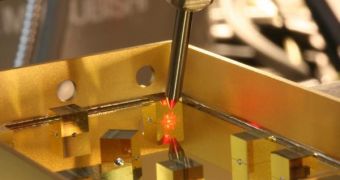The issue with optical devices in space is that the extremely low pressure determines the adhesive that keeps them in place to release gases that either contaminate the lenses or move the lenses a couple of microns out of their original setting place. The same effect can be obtained while subjecting the adhesive material to high temperatures of lasers in the ultraviolet wavelengths.
The answer given to this problem by the Fraunhofer Institute for Applied Optics and Precision Engineering IOF is solder. "We solder the optical components instead of gluing them. This has a definite advantage: the solder material is resistant to extreme temperatures and radiation and also conducts heat and electricity", said Dr.-Ing. Erik Beckert, group manager at IOF.
The technique used in applying the solder is rather similar to the 'solder bumping' method employed in electronics manufacturing and involves melting a small solder ball into a liquid state with the help of the laser, after which the solder drops are shot to the designated spot with the help of a short nitrogen pulse. As the liquid drop makes contact with the lens and the holding platform, it cools immediately and solidifies, fixing the lens into place.
"This process can be automated and very flexible. We can apply the solder downwards or from various other angles and in places that are difficult to access", said Beckert. Adhesive fixing usually takes between 10 to 30 seconds, depending on the adhesive application time and its hardening properties. Soldering on the other hand, only takes a second. The glass surfaces are metallized, to ensure that the solder sticks to the lens.
Unlike, the electronics manufacturing solder that requires flux to ensure a full coating, the solder developed at IOF does not require any. "Normally, flux is used to ensure that the solder fully coats the metal. However, in a vacuum, the flux residues would outgas in a similar way to adhesives. The lens system would have to be thoroughly cleaned before being used. That's not necessary with the flux-free version", said Beckert.
The solder bumping method and a prototype of optical components fixed with it will be presented in Frankfurt at Optatec, which will take place between June 17 and June 20.

 14 DAY TRIAL //
14 DAY TRIAL //